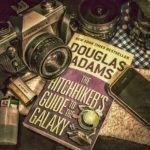The holidays are over; winter is upon us. Time to hunker down and write The Great American Novel. Having taught creative writing and run workshops for years, I offer my personal top five tips:
- KNOW WHERE YOU’RE GOING BEFORE YOU WRITE THE FIRST WORD. Many will disagree with me, but in my experience a whole lot of writing time is wasted otherwise. You’re either compulsing over material that just gets cut later or…worse…gets left in to drag down the quality of your writing. Know the basic three-act structure that applies to everything from a non-fiction article to a novel to a screenplay. (Syd Field’s concise description of this paradigm, in his books on screenwriting, is a great way to master this quickly.) Know the end of your story. This is the only way you can flip to the opposite state of affairs…like the negative for a black-and-white photo…and construct the beginning.
- DON’T WASTE A SINGLE SYLLABLE. Pretend a psychotic suffering from extreme attention deficit disorder has a gun pointed at your head and has demanded that you tell a great story…with eyes that are already starting to glass over with impatience before you can open your mouth to say the first word. Don’t think you’ll ever have enough to fill the pages of a novel this way? Fear not; this is only the first draft. As you write, further developing subplots and the twists and turns of your story, you’ll find yourself going back to weave more into the beginning.
- MULTITASK YOUR WRITING. Every word should serve a purpose in your story and hopefully more than one purpose. The ideal is to have a character utter a single syllable…like “No!”…which simultaneously reveals an aspect of the character not known before, creates a plot twist because no one (including the reader) expected this, and maybe provides comic relief in the midst of heavy tension. This is particularly important when you find yourself needing to go back and weave some foreshadowing into an earlier scene. Otherwise, since the reader doesn’t yet know that this information will turn out to be important later, your foreshadowing can seem like useless and unnecessary flab.
- SHOW DON’T TELL. This has been said by many others many times, but it’s amazing how many writers will still write “Aunt Petunia was nervous,” instead of “Aunt Petunia started biting her nails.”
- SURPRISE YOUR READER. No one wants to read a predictable story. I suggest a triangle structure in which you start each chapter or scene at Point A, head toward Point B, but somehow end up at Point C instead. (Example: Character A is trying to seduce Character B, but somehow ends up in bed with Character C instead.)







